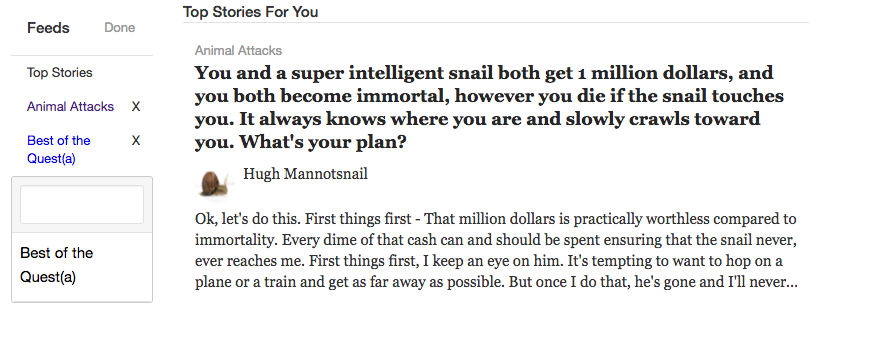Questa is a Q&A web application inspired by popular Q&A forum Quora and built using Ruby on Rails and React.js/flux architecture. Questa allows users to:
- Create an account
- Log in and out
- View questions on their main feed along with a preview of one of the answers.
- Ask new questions
- View answers to questions
- Add their own answers
- View comments on answers
- Add their own comments to answers
- View existing questions by topic.
- Search topics and edit a list of their favorite topics.
- View topic pages displaying only those questions tagged with a given topic.
The app was built using Ruby on Rails on the backend with a postgreSQL database. The app makes use of RESTful routes and requests to the database are handled using AJAX queries. The responses are rendered as JSON objects using JBuilder to specify the precise structure of the output.
The front end is built completely in React.js and uses React's Flux architecture. Modals use conditional rendering of React components rather than manipulation of CSS display properties. This approach reduces queries to the database to their absolute minimum.
Questa uses BCrypt within Rails to hash passwords and save the resulting password digests to the database. To check a user's password the user's input is hashed and compared against the database's password digest.
Questa's query bar at the top of each page pulls double duty as a search tool and a user input form. A user can type their question and the app will filter the questions in the database and render links to those which include the user's query. Should the user not find what they're looking for, clicking the "Just do it!" button will create a new question and add it to the database.
Questa's homepage is a default question feed showing all questions in the database, with links to their question page and any relevant topic pages. Should a user want to look at all questions within a certain topic, they can link to a topic page with a feed that only contains questions pertaining to that topic.
Individual question pages display the question and all answers. Users can add their own answers and comment on the answers of others. Using Flux architecture new answers and comments are added to the page seamlessly without need for a new AJAX query.
Each user is associated in the Rails database with some number of topics through their "follows." These favorite topics are rendered on the left sidebar as links to their topic pages. This favorites list can be dynamically edited, by searching the topic list by topic name or deleting topics from the list. Edits show up immediately on the frontend through updates to the store, while posting to the backend for sake of permanence.




